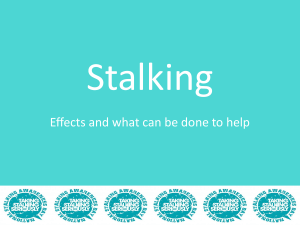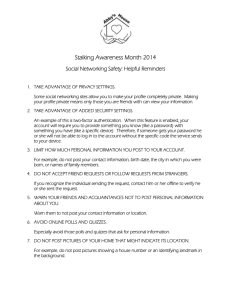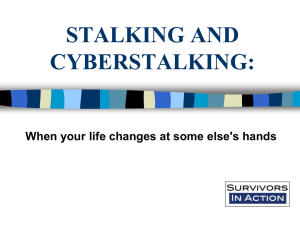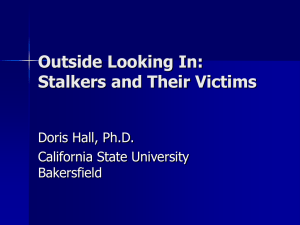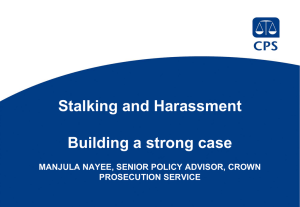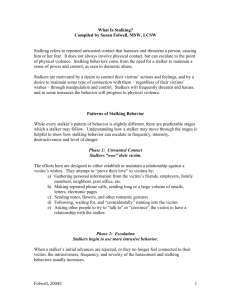Stalking: Recognizing and Responding to the Problem
advertisement
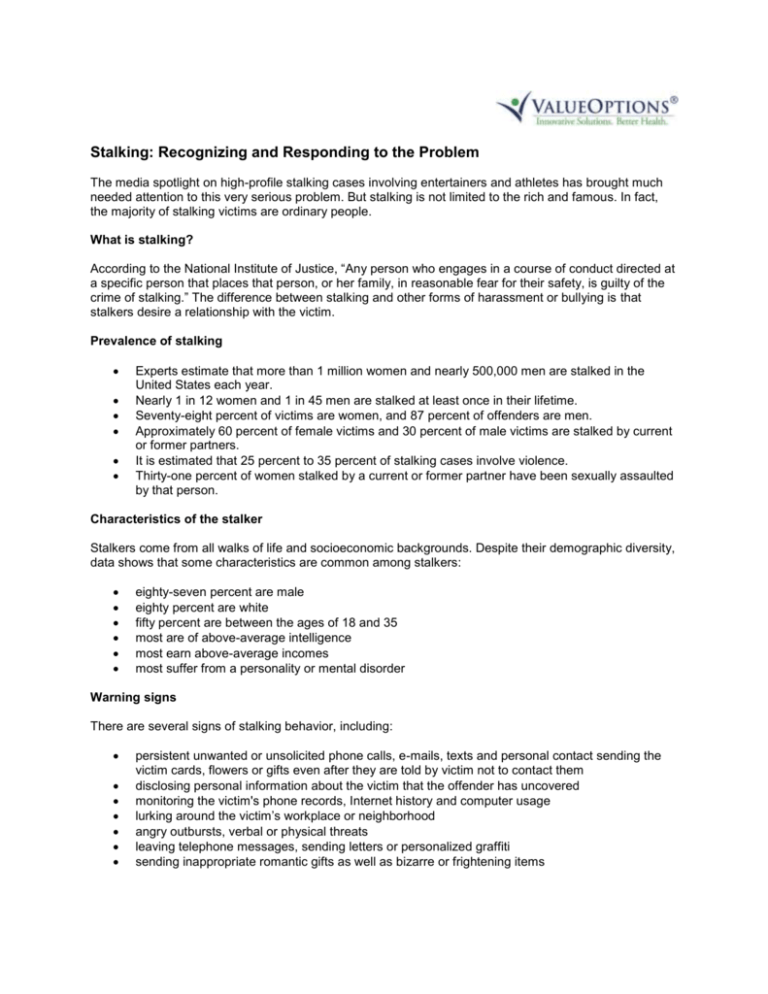
Stalking: Recognizing and Responding to the Problem The media spotlight on high-profile stalking cases involving entertainers and athletes has brought much needed attention to this very serious problem. But stalking is not limited to the rich and famous. In fact, the majority of stalking victims are ordinary people. What is stalking? According to the National Institute of Justice, “Any person who engages in a course of conduct directed at a specific person that places that person, or her family, in reasonable fear for their safety, is guilty of the crime of stalking.” The difference between stalking and other forms of harassment or bullying is that stalkers desire a relationship with the victim. Prevalence of stalking Experts estimate that more than 1 million women and nearly 500,000 men are stalked in the United States each year. Nearly 1 in 12 women and 1 in 45 men are stalked at least once in their lifetime. Seventy-eight percent of victims are women, and 87 percent of offenders are men. Approximately 60 percent of female victims and 30 percent of male victims are stalked by current or former partners. It is estimated that 25 percent to 35 percent of stalking cases involve violence. Thirty-one percent of women stalked by a current or former partner have been sexually assaulted by that person. Characteristics of the stalker Stalkers come from all walks of life and socioeconomic backgrounds. Despite their demographic diversity, data shows that some characteristics are common among stalkers: eighty-seven percent are male eighty percent are white fifty percent are between the ages of 18 and 35 most are of above-average intelligence most earn above-average incomes most suffer from a personality or mental disorder Warning signs There are several signs of stalking behavior, including: persistent unwanted or unsolicited phone calls, e-mails, texts and personal contact sending the victim cards, flowers or gifts even after they are told by victim not to contact them disclosing personal information about the victim that the offender has uncovered monitoring the victim's phone records, Internet history and computer usage lurking around the victim’s workplace or neighborhood angry outbursts, verbal or physical threats leaving telephone messages, sending letters or personalized graffiti sending inappropriate romantic gifts as well as bizarre or frightening items A list of descriptive behaviors is not always sufficient to determine whether one is being stalked, so trust your gut. If you feel a bit “creepy” about a gift or encounter, or that your personal boundaries have been violated, speak out about it. Remember: Real love never makes you feel uncomfortable. Three common types of stalkers 1. Simple obsessional. This is the most common type. The stalker is usually a male, and the victim an ex-spouse, ex-lover or former boss. This type of stalking usually results from the stalker's perceptions that the victim has mistreated him or her. 2. Love obsessional. The stalker is a casual acquaintance or even a stranger to the victim. This type often stalks a celebrity or public figure. The love-obsessed stalker begins to organize his life around the target of his obsession, hoping to make the victim aware of his existence. The level of harassment increases as the stalker’s attempts to gain recognition are ignored. 3. Erotomania. This type of stalker falsely believes that the object of his obsession is secretly in love with him. He wrongly assumes that someone—usually a wife or lover—is keeping them from being together. The victims are commonly rich or famous, or perceived as powerful. What to do if you are being stalked If you or someone you know is a victim of stalking, contact law enforcement with your concerns. Most law enforcement agencies now employ anti-stalking personnel who are specially trained to help victims of stalking. The U.S. Department of Justice recommends the following preventive measures for anyone who feels threatened by a stalker: Install dead bolts and change locks. Install adequate outside lighting. Maintain an unlisted telephone number. If harassing phone calls persist, notify law enforcement. Treat any threats as legitimate and inform law enforcement. Use different travel routes and refrain from walking alone when possible. Inform a trusted neighbor or friend about the situation. If necessary, provide friends or neighbors with a photo or description of the individual and vehicles he may drive. If residing in an apartment with an on-site manager, provide the manager with a picture or description of the stalker. Have co-workers screen calls and visitors. When out, stay in highly visible and populated areas and try not to travel alone. Have quick access to contact information for law enforcement agencies. Make a plan to stay with friends when danger is perceived. Cyberstalking According the National Center for Victims of Crime: “Cyberstalking can be defined as threatening behavior or unwanted advances directed at another using the Internet and other forms of online and computer communications”. Similar to stalking off-line, online stalking is a terrifying experience for victims, placing them at risk of psychological trauma, and possible physical harm. Many cyberstalking situations evolve into off-line stalking. The victim may experience abusive and excessive phone calls, vandalism, threatening or obscene mail, trespassing, and physical assault. Just because cyberstalking does not include physical contact with the perpetrator does not mean it is not as threatening or frightening as any other type of crime. Victims of cyberstalking often experience psychological trauma as a result of their victimization. Some of these effects may include: changes in sleeping and eating patterns nightmares hypervigilance anxiety feelings of helplessness fear for owns safety What to do? Experts suggest that in cases where the offender is known, victims should send the stalker a clear written warning. Specifically, victims should communicate that the contact is unwanted, and ask the perpetrator to cease sending communications of any kind. Victims should do this only once. Then, no matter the response, victims should under no circumstances ever communicate with the stalker again. Victims should save copies of this communication in both electronic and hard copy form. Victims who are under the age of 18 should tell their parents or another adult they trust about any harassments and/or threats. If the harassment continues, the victim may wish to file a complaint with the stalker's Internet service provider, as well as with their own service provider. Many Internet service providers offer tools that filter or block communications from specific individuals. As soon as individuals suspect they are victims of online harassment or cyberstalking, they should start collecting all evidence and document all contact made by the stalker. Save all e-mails, postings, or other communications in both electronic and hard-copy form. If possible, save all of the header information from e-mails and newsgroup postings. Record the dates and times of any contact with the stalker. Victims may also want to start a log of each communication explaining the situation in more detail. Victims may want to document how the harassment is affecting their lives and what steps they have taken to stop the harassment. Victims may want to file a report with local law enforcement or contact their local prosecutor's office to see what charges, if any, can be pursued. Victims should save copies of police reports and record all contact with law enforcement officials and the prosecutor's office. Victims who are being continually harassed may want to consider changing their e-mail address, Internet service provider, a home phone number, and should examine the possibility of using encryption software or privacy protection programs. Any local computer store can offer a variety of protective software, options and suggestions. Victims may also want to learn how to use the filtering capabilities of email programs to block e-mails from certain addresses. Finally, under no circumstances should victims agree to meet with the perpetrator face to face to "work it out," or "talk." Meeting a stalker in person can be very dangerous. If you are being stalked or suspect that you are, talk with someone right away. Those closest to you will understand, especially if it is a former boyfriend, girlfriend or spouse. Although these people can provide much needed comfort, you must also talk with someone who knows about how to deal with stalking. Most police departments have specialists in this area and most counselors are trained in how to deal with stalking. Life is too short to live in fear. Trust your gut and get some help. Do not go this alone. By Drew W. Edwards,MS, EdD, © 2011-2014 Achieve Solutions®
